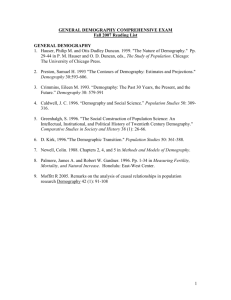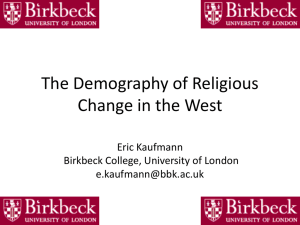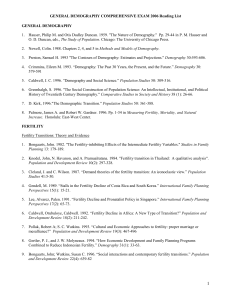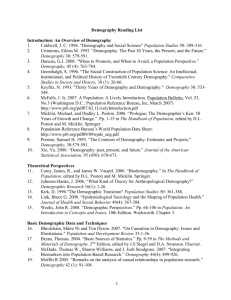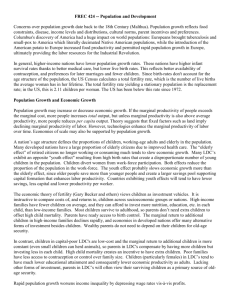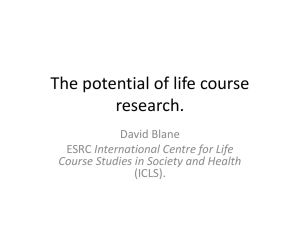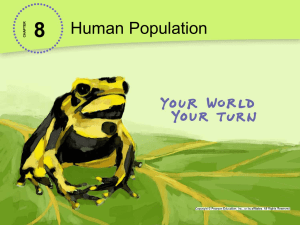general approaches to the study of population (soc 389k
advertisement
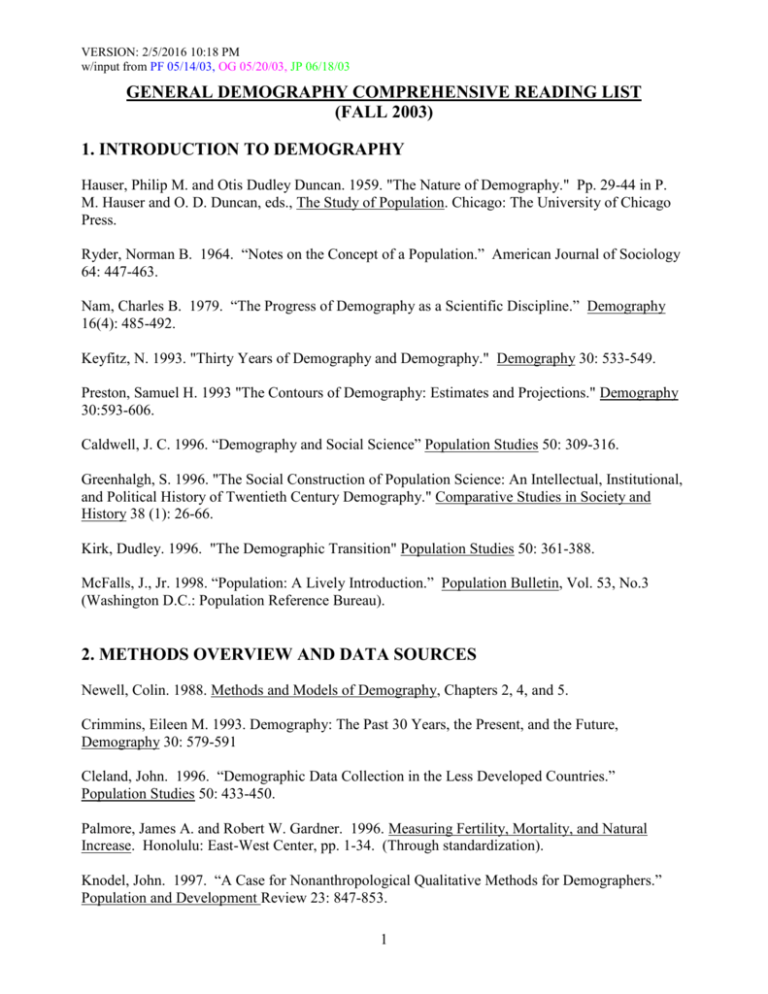
VERSION: 2/5/2016 10:18 PM w/input from PF 05/14/03, OG 05/20/03, JP 06/18/03 GENERAL DEMOGRAPHY COMPREHENSIVE READING LIST (FALL 2003) 1. INTRODUCTION TO DEMOGRAPHY Hauser, Philip M. and Otis Dudley Duncan. 1959. "The Nature of Demography." Pp. 29-44 in P. M. Hauser and O. D. Duncan, eds., The Study of Population. Chicago: The University of Chicago Press. Ryder, Norman B. 1964. “Notes on the Concept of a Population.” American Journal of Sociology 64: 447-463. Nam, Charles B. 1979. “The Progress of Demography as a Scientific Discipline.” Demography 16(4): 485-492. Keyfitz, N. 1993. "Thirty Years of Demography and Demography." Demography 30: 533-549. Preston, Samuel H. 1993 "The Contours of Demography: Estimates and Projections." Demography 30:593-606. Caldwell, J. C. 1996. “Demography and Social Science” Population Studies 50: 309-316. Greenhalgh, S. 1996. "The Social Construction of Population Science: An Intellectual, Institutional, and Political History of Twentieth Century Demography." Comparative Studies in Society and History 38 (1): 26-66. Kirk, Dudley. 1996. "The Demographic Transition" Population Studies 50: 361-388. McFalls, J., Jr. 1998. “Population: A Lively Introduction.” Population Bulletin, Vol. 53, No.3 (Washington D.C.: Population Reference Bureau). 2. METHODS OVERVIEW AND DATA SOURCES Newell, Colin. 1988. Methods and Models of Demography, Chapters 2, 4, and 5. Crimmins, Eileen M. 1993. Demography: The Past 30 Years, the Present, and the Future, Demography 30: 579-591 Cleland, John. 1996. “Demographic Data Collection in the Less Developed Countries.” Population Studies 50: 433-450. Palmore, James A. and Robert W. Gardner. 1996. Measuring Fertility, Mortality, and Natural Increase. Honolulu: East-West Center, pp. 1-34. (Through standardization). Knodel, John. 1997. “A Case for Nonanthropological Qualitative Methods for Demographers.” Population and Development Review 23: 847-853. 1 VERSION: 2/5/2016 10:18 PM w/input from PF 05/14/03, OG 05/20/03, JP 06/18/03 Boerma, J. Ties, Elizabeth Holt, and Robert Black. 2001. “Measurement of Biomarkers in Surveys in Developing Countries: Opportunities and Problems.” Population and Development Review 27(2): 303-314. Dyson, Tim. 2001. “The Preliminary Demography of the 2001 Census of India.” Population and Development Review 27(2): 341-356. Kent, Mary M., Kelvin M. Pollard, John Haaga, and Mark Mather. 2001. “First Glimpses From the 2000 U.S. Census.” Population Bulletin 56(2). Preston, Samuel H., Patrick Heuveline, and Michel Guillot. 2001. Demography: Measuring and Modeling Population Processes. Oxford: Blackwell Publishers. Chapters 1-3 (pages 1-68). Weeks, John R. 2002. “Demographic Data.” Pp. 41-77 in Population: An Introduction to Concepts and Issues, 8th edition. Wadsworth. 3. FERTILITY A. THE FERTILITY TRANSITION: THEORY AND HISTORY Davis, Kingsley, and Judith Blake. 1956. “Social Structure and Fertility: An Analytic Framework.” Economic Development and Cultural Change 4: 211-235. Cleland, John and Christopher Wilson. 1987. “Demand theories of the fertility transition: An iconoclastic view.” Population Studies 41:5-30. Watkins, Susan C. 1990. "From local to national communities: The transformation of demographic regimes in Western Europe, 1870-1960". Population and Development Review 16(2): 241-272. Pollak, Robert A. and Watkins, Susan Cotts. 1993. “Cultural and economic approaches to fertility: Proper marriage or mesalliance?” Population and Development review. 19: 467-496. Bongaarts, John; Watkins, Susan C. 1996. “Social interactions and contemporary fertility transitions.” Population and Development Review 22(4): 639-82. Mason, K. O. 1997. “Explaining fertility transitions.” Demography 34(4): 443-54. Axinn, William G. and Jennifer S. Barber 2001. “Mass education and fertility transition.” American Sociological Review, 66(4): 481-505. Potter, Joseph E., Carl P. Schmertmann, and Suzana M. Cavenaghi. 2002. “Fertility and Development in Brazil.” Demography 39(4): 739-762. 2 VERSION: 2/5/2016 10:18 PM w/input from PF 05/14/03, OG 05/20/03, JP 06/18/03 Brown, John C. and Timothy Guinanne. 2002. “The Fertility Transition in a rural Catholic population: Bavaria 1880 – 1910.” Population Studies 56: 35-50. (originally unpublished working paper, 2000) B. FERTILITY TRANSITIONS IN DEVELOPING COUNTRIES AND LOW FERTILITY REGIMES Knodel, John, N. Havanon, and A. Pramualratana. 1984. "Fertility transition in Thailand: A qualitative analysis". Population and Development Review 10(2): 297-328. Delgado Perez, Marita, and Massimo Livi-Bacci. 1992 “Fertility in Italy and Spain: The Lowest in the World.” Family Planning Perspectives 24(4): 162-171. Entwisle B, Rindfuss RR, Guilkey DK, Chamratrithirong A, Curran SR, Sawangdee Y. 1996. Community and contraceptive choice in rural Thailand: A case study of Nang Rong, Demography. 33 (1): 1-11. Forste, Renata, and Marta Tienda. 1996. “What’s Behind Racial and Ethnic Fertility Differentials?” Population and Development Review 22(supplement): 109-133. Morgan, S. Philip. 1996. “Characteristic Features of Modern American Fertility” Population and Development Review. 22(Supplement): 19-63. Schoen, Robert, Young J. Kim, Constance A. Nathanson, Jason Fields, and Nan Marie Astone. 1997. “Why Do Americans Want Children?” Population and Development Review 23(2): 333358. Bledsoe, Caroline, Fatoumatta Banja, and Allan G. Hill. 1998. Reproductive mishaps and western contraception: An African challenge to fertility theory.” Population and Development Review. 24: 15-57. Bongaarts, J. 2001. “Fertility and Reproductive Preferences in Post-Transitional Societies.” In Bulatao and Casterline (eds) Global Fertility Transition. Rindfuss, Ronald R., Karen Benjamin and S. Philip Morgan. 2000. “The Changing Institutional Context of Low Fertility.” Working paper, currently in press. (JP) Raley, R. Kelly. 2001. Increasing Fertility in Cohabiting Unions: Evidence for the Second Demographic Transition in the United States?” Demography 38(1): 59-66. Schoen, Robert, and Nicola Standish. 2001. “The Retrenchment of Marriage: Results from Marital Status Life Tables for the United States, 1995.” Population and Development Review 27(3): 553564. Bongaarts, John. 2002. “The End of the Fertility Transition in the Developed World.” Population and Development Review 28(3): 419-444. 3 VERSION: 2/5/2016 10:18 PM w/input from PF 05/14/03, OG 05/20/03, JP 06/18/03 Kohler, Hans-Peter, Francesco C. Billari and Jose Antonio Ortega. 2002. “The Emergence of Lowest-Low Fertility in Europe During the 1990s.” Population and Development Review 28(4): 641 – 87. (JP) Demeney. 2003. Population and Development Review (JP) Morgan. 2003. Presidential Address, Population Association of America. (JP) C. FAMILIES AND FERTILITY Bumpass, Larry L. 1990. “What’s Happening to the Family?” Demography, 27: 483-498. Smith, Herbert, Morgan, S. Philip and Tanya Koropeckyj-Cox. 1996. “A Decomposition of Trends in the Nonmarital Fertility Ratios of Blacks and Whites in the United States, 1960-92. Demography, 33: 141-51. Morgan SP, Rindfuss RR . 1999. Reexamining the link of early childbearing to marriage and to subsequent fertility. Demography 36 (1): 59-75. Bumpass, Larry L. and Hsien-Hen Lu. 2000. "Trends in Cohabitation and Implications for Children's Family Contexts in the United States". Population Studies 54:29-41. Thornton A. 2001. “The developmental paradigm, reading history sideways, and family change.” Demography, 38 (4): 449-465. 4. MORTALITY A. EPIDEMIOLOGICAL TRANSITION McKeown, Thomas and R.G. Record.1962, “Reasons for the Decline of Mortality in England and Wales during the Nineteenth Century.” Population Studies. 16(2): 94-122. Omran, Abdel R. 1971. “The Epidemiologic Transition: A Theory of the Epidemiology of Population Change.” Milbank Memorial Fund Quarterly 49: 509-538.(PF) Palloni, Alberto.1981. "Mortality in Latin America: Emerging Patterns" Population and Development Review, Vol 7(4), Pp.623-650. Omran, Abdel R. 1982. “Epidemiologic Transition.” Pp. 172-183 in International Encyclopedia of Population, edited by John Ross. The Free Press, Volume 1. Mosley, W. H. and L. C. Chen. 1984. An Analytic Framework for the Study of Child Survival in Developing Countries. Population and Development Review 10 (supplement): 25-48. Preston, Samuel H. 1985. "Mortality and development revisited." Population Bulletin of the United Nations, No. 18. New York: United Nations, 34-40. 4 VERSION: 2/5/2016 10:18 PM w/input from PF 05/14/03, OG 05/20/03, JP 06/18/03 Caldwell, J. 1986."Routes to Low Mortality in Poor Countries." Population and Development Review 12: 171-220. Olshansky, J., and Brian Ault. 1986. “The Fourth Stage of the Epidemiologic Transition: the Age of Degenerative Diseases.” The Milbank Quarterly 64(3): 355-391. Frenk, J., Bobadilla, J.L., Sepulveda, J., and M. Lopez. 1989. “Health Transition in Middle Income Countries: New Challenges for Health Care.” Health and Policy Planning 4(1): 29-39.(PF) R. Schofield and D. Reher, 1991. “The Decline of Mortality in Europe” in R. Schofield, D. Reher and A.Bideau (eds.) The Decline of Mortality in Europe, Oxford: Clarendon Press, Pp 1-17. Bongaarts, John. 1996. Global Trends in AIDS Mortality. Population and Development Review 22: 21-45. Olshansky et al. 1997: "Infectious Diseases -- New and Ancient Threats to World Health." Population Bulletin 52 (2). Salomon, Joshua A., and Christopher J.L. Murray. 2002. “The Epidemiologic Transition Revisited: Causes of Death by Age and Sex.” Population and Development Review 28(2): 205-228. B. INFANT MORTALITY Pampel, Fred C., Jr. and Vijayan Pillai. 1986. “Patterns and Determinants of Infant Mortality in Developed Nations, 1950-1975.” Demography. 23 (Nov.): 525-42. Cramer, J.C. 1987. “Social Factors and Infant Mortality: Identifying High-Risk Groups and Proximate Causes.” Demography 24: 299-322.(PF) Eberstein, Isaac W. 1989. “Demographic Research on Infant Mortality.” Sociological Forum 4 (3): 409-22. Eberstein, Isaac W., Charles B. Nam, and Robert A. Hummer. 1990. “Infant Mortality by Cause of Death: Main and Interaction Effects.” Demography 27: 413-430. Forbes, Douglas and W. Parker Frisbie. 1991. “Spanish Surname and Anglo infant mortality: differentials over a half-century.” Demography 28 (4) (Nov.): 639-60. Scribner, R. 1996. "Editorial: Paradox as Paradigm - The Health Outcomes of Mexican Americans." American Journal of Public Health 86: 303-305. Frisbie, WP, M Biegler, P de Turk, D Forbes, and SG Pullum. 1997. “Racial and Ethnic Differences in Determinants of Intrauterine Growth Retardation and Other Compromised Birth Outcomes.” American Journal of Public Health (December) 87: 1977-83. Gortmaker, Stephen L., and Paul H. Wise. 1997. “The First Injustice: Socioeconomic Disparities, Health Services Technology, and Infant Mortality.” Annual Review of Sociology 23: 147-170. 5 VERSION: 2/5/2016 10:18 PM w/input from PF 05/14/03, OG 05/20/03, JP 06/18/03 Frisbie, W.P., Forbes, D., and R.A. Hummer. 1998. “Hispanic Pregnancy Outcomes: Additional Evidence.” Social Science Quarterly 79: 149-169.(PF) Hummer, Robert A, Monique Biegler, Peter B. de Turk, Douglas Forbes, W. Parker Frisbie, Ying Hong, and Starling Pullum. 1999. "Race/Ethnicity, Nativity, and Infant Mortality in the Unites States." Social Forces. 77 (3): 1083-1118. Landale NS, Oropesa RS, Gorman BK 2000. “Migration and infant death: Assimilation or selective migration among Puerto Ricans?”American Sociological Review. 65 (6): 888-909. Frisbie, W. Parker. 2004. “Infant Mortality.” Forthcoming in Handbook of Population, edited by D. Poston and M. Micklin. NY: Kluwer/Plenum Academic Publishers. C. ADULT MORTALITY AND MORBIDITY DIFFERENTIALS Gove, Walter R. 1973 "Sex, Marital Status, and Mortality." American Journal of Sociology 79: 4567. Kitagawa, E.M., and P.M. Hauser. 1973. Differential Mortality in the United States: A Study in Socioeconomic Epidemiology. Cambridge, MA: Harvard University Press. Browse all; read: introductory and concluding chapters. Nathanson, Constance. 1984 "Sex Differences in Mortality." Annual Review of Sociology 10: 191213. Pappas, G., S. Queen, W. Hadden, and G. Fisher. 1993. “The Increasing Disparity in Mortality Between Socioeconomic Groups in the United States, 1960 and 1986.” New England Journal of Medicine 329: 103-109. Lillard, L.A., and L. Waite. 1995. “Til Death Do Us Part: Marital Disruption and Mortality.” American Journal of Sociology 100: 1131-1156. Preston, S.H., and I.T. Elo. 1995. “Are Educational Differentials in Adult Mortality Increasing in the United States?” Journal of Aging and Health 7: 476-496. Rogers, Richard G. 1995 "Marriage, Sex, and Mortality." Journal of Marriage and the Family 57 (May): 515-526. Smith, James P. and Raynard Kington. 1997. “Demographic and Economic Correlates of Health in Old Age.” Demography, 34(1):159-170. Hummer, Robert A., Richard Rogers, and Isaac W. Eberstein. 1998 "Sociodemographic Differences in U.S. Adult Mortality: A Review of Analytic Approaches." Population Development and Review 24: 553-578. 6 VERSION: 2/5/2016 10:18 PM w/input from PF 05/14/03, OG 05/20/03, JP 06/18/03 Rogers, R., R. Hummer, and C. Nam. 2000. Living and Dying in the USA: Behavioral, Health and Social Differentials of Adult Mortality. San Diego: Academic Press. Chapters 3, 4, 6 (Chapters on gender, race/ethnicity, religion). Browse others. Huie, Stephanie, Hummer, Robert A. and Richard Rogers. 2002. Journal of Health and Social Behavior. Singh, G.K., and M. Siahpush. 2002. “Ethnic-Immigrant Differentials in Health Behaviors, Morbidity, and Cause-Specific Mortality in the United States: An Analysis of Two National Data Bases.” Human Biology 74(1): 83-109. Rogers, Richard, Robert Hummer, and Patrick Krueger. 2003. “Adult Mortality.” Forthcoming in Handbook of Population, edited by D. Poston and M. Micklin. NY: Kluwer/Plenum Academic Publishers. Williams, Kristi and Debra Umberson. (forthcoming 2003). “Marital Status, Marital Transitions, and Health: A Gendered Life Course Perspective.” Journal of Health and Social Behavior. (formerly paper presented at 2001 ASA) 5. MIGRATION A. THEORIES OF MIGRATION Lee, Everett. 1966. “A Theory of Migration.” Demography 3: 47-57. Sell, Ralph R. 1983. “Analyzing Migration Decisions: The First Step—Whose Decisions?.” Demography 20: 299-311.(OG) McNeil, W. 1984. “Human Migration in Historical Perspective.” Population and Development Review 10: 1-18. Massey, D. 1987. “The Social Process of International Migration.” Science 237(4816): 733-738. Massey, Douglas, et al. 1993. “Theories of International Migration: A Review and Appraisal.” Population and Development Review 19: 431-466. Alba, Richard and Victor Nee. 1997. “Rethinking Assimilation for a New Era of Immigrants.” International Migration Review. 31 (4): 826-74. Portes, A. 1997. “Immigration theory for a new century: Some problems and opportunities.” International Migration Review 31(4): 799-825. Zhou, Min. 1997. Segmented assimilation: Issues, controversies, and recent research on the new second generation. International Migration Review 31(4):975- . 7 VERSION: 2/5/2016 10:18 PM w/input from PF 05/14/03, OG 05/20/03, JP 06/18/03 Ainsworth-Darnell JW, Downey DB. 1998. “Assessing the oppositional culture explanation for racial/ethnic differences in school performance” American Sociological Review 63(4): 536-553. Massey, D. 1999. International Migration at the Dawn of the Twenty-First Century: The Role of the State (in Notes and Commentary). Population and Development Review, Vol. 25, No. 2. (Jun., 1999), pp. 303-322 B. INTERNATIONAL MIGRATION AND ITS CONSEQUENCES Donato, Katharine, Jorge Durand and Douglas S. Massey. 1992. “Stemming the Tide? Assessing the Deterrent Effects of the Immigration Reform and Control Act.” Demography 29: 139-157. Massey, Douglas A. Joaquin Arango, Graeme Hugo, Ali Kouaouci, Adela Pellegrino, and J. Edward Taylor. 1994. "An Evaluation of International Migration Theory: The North American Case." Population and Development Review. 20: 699-751. Frey, William H. 1995. Immigration, Domestic Migration, and Demographic Balkanization in America: New Evidence for the 1990s. Urban Studies 32 (4-5): 733-757. United Nations High Commissioner for Refugees. 1995. “Managing Migration.” Chapter 5 (pp. 187-231) in The State of the World’s Refugees: In Search of Solutions. Oxford: Oxford University Press.(OG) Massey DS, Espinosa KE. 1997. “What's driving Mexico-US migration? A theoretical, empirical, and policy analysis.” American Journal of Sociology 102 (4): 939-999. White MJ, Liang Z. 1998. “The effect of immigration on the internal migration of the native-born population, 1981-1990.” Population Research and Policy Review. 17 (2): 141-166. Kanaiaupuni SM. 2000. “Reframing the migration question: An analysis of men, women, and gender in Mexico.” Social Forces. 78 (4): 1311-1347. Kritz MM, Gurak DT. 2001. “The impact of immigration on the internal migration of natives and immigrants.” Demography 38 (1): 133-145. Palloni A, Massey DS, Ceballos M, et al. 2001. Social capital and international migration: A test using information on family networks. American Journal of Sociology. 106 (5): 1262-1298. Massey, Douglas S., Jorge Durand and Nolan J. Malone. 2002. Beyond Smoke and Mirrors: Mexican Immigration in an Era of Economic Integration. New York: The Russell Sage Foundation.(OG) Bean, Frank D. and Gillian Stevens. 2003. America’s Newcomers and the Dynamics of Diversity. New York: The Russell Sage Foundation.(OG) Bean, Frank D. and Stephanie Bell-Rose, eds. 2003. Immigration and Opportunity: Race, Ethnicity, and Employment in the United States. New York: The Russell Sage Foundation.(OG) 8 VERSION: 2/5/2016 10:18 PM w/input from PF 05/14/03, OG 05/20/03, JP 06/18/03 Ehrenreich, Barbara and Arlie R. Hochschild, eds. 2003. Global Woman: Nannies, Maids, and Sex Workers in the New Economy. New York: Metropolitan Books.(OG) C. URBANIZATION, SEGREGATION AND INEQUALITY Davis, Kingsley. 1955. “The Origin and Growth of Urbanization in the World.” American Journal of Sociology 60: 429-437. Wilson, William J. 1987. The Truly Disadvantaged. Chapter 2. Chicago: University of Chicago Press. Frisbie, W.P., and J.D. Kasarda. 1988. “Spatial Processes.” Pp. 629-660 in Neil Smelser (ed.) Handbook of Sociology Beverley Hills: Sage.(PF) Massey, D.S., N. Denton. 1989. “Hypersegregation in U.S. Metropolitan Areas: Black and Hispanic Segregation Along Five Dimensions.” ASR 52:805-825.(PF) Massey DS, Eggers M. 1990. The Ecology of Inequality - Minorities and the Concentration Of Poverty, 1970-1980.” American Journal of Sociology. 95 (5): 1153-1188. Massey DS, Eggers M. 1995. Beyond The Technical Details – Reply. American Journal of Sociology. 100 (5): 1333-1335. St. John, Craig. 1995. “Interclass Segregation, Poverty, and Poverty Concentration – Comment.” American Journal of Sociology. 100 (5): 1325-1333. Jargowsky, Paul A. 1996. “Take the Money and Run: Economic Segregation in U.S. Metropolitan Areas”. American Sociological Review 61(6): 984-998.(OG) Massey, DS. 1996. “The Age of Extremes: Concentrated Affluence and Poverty in the 21st Century.” Demography 33(4): 395-412. (Also see 4 responses to this article in that same issue). Morenoff, Jeffrey D. and Robert J. Sampson. 1997 “Violent Crime and the Spatial Dynamics of Neighborhood Transition: Chicago, 1970-1990.” Social Forces 76: 31-64.(OG) Brockerhoff, Martin, and Ellen Brennan. 1998. “The Poverty of Cities in Developing Regions.” Population and Development Review 24: 75-114. Harris DR. 1999. "Property values drop when blacks move in, because..": Racial and socioeconomic determinants of neighborhood desirability.” American Sociological Review. 64(3): 461-479. Quillian L. 1999. “Migration patterns and the growth of high-poverty neighborhoods, 1970-1990. American Journal of Sociology. 105 (1): 1-37. Glaeser, E. L., and J. L. Vigdor. 2001 Racial Segregation in the 2000 Census: Promising News.” The Brookings Institution Survey Series April: 1-16.(OG) Sassen, Saskia. 2002. Global Networks, Linked Cities. New York: Routledge, 2002.(OG) 9 VERSION: 2/5/2016 10:18 PM w/input from PF 05/14/03, OG 05/20/03, JP 06/18/03 Suro, Peter, and Audrey Singer. 2002 “Latino Growth in Metropolitan America: Changing Patters, New Locations.” The Brookings Institution Survey Series, Census 2000.(OG) 6. LAGNIAPPE A. HOUSEHOLD STRUCTURE AND WELL-BEING McLanahan and Casper 1995. "Growing Diversity and Inequality in American Families." in Farley (ed.) The State of the Union, Volume 2:Social Trends. New York: Russell Sage. Wu, Lawrence L. 1996. "Effects of family instability, income, and income instability on the risk of a premarital birth." American Sociological Review. 61(3): 386-407 Lichter, Daniel T. 1997. Poverty and Inequality among Children. Annual Review of Sociology. 23: 121-45. Hanson, Thomas L., Sara S. McLanahan, and Elizabeth Thomson. 1998. "Windows on Divorce: Before and After." Social Science Research 27:329-49. Cherlin, Andrew. 1999. “Going to Extremes: Children’s Well-being and Social Science.” Demography. 36(4): 421-428. Amato, Paul R. 2000. "The Consequences of Divore for Adults and Children." Journal of Marriage and the Family 62: 1269-1287. Smock, Pamela J. Wendy Manning, and Sanjiv Gupta. 2000. "The Effect of Marriage and Divorce on Women's Economic Well-Being." American Sociological Review. B. AGING AND THE LIFE COURSE Elder, Glen. 1975. Age Differentiation and the Life Course. Annual Review of Sociology, 1:165190. Geronimus, A. T. and S. Korenman. 1993. Maternal Youth or Family Background?: On the Health Disadvantages of Infants with Teenage Mothers. American Journal of Epidemiology: 137: 21325.(PF) Smith, J.P. and R.S. Kingston. 1997. “Race, Socioeconomic Status, and Health in Later Life.” Pp. 106-162 in Linda G. Martin and Beth J. Soldo (eds.) Racial and Ethnic Differences in the Health of Older Americans. Washington, DC: National Academy Press.(PF) Angel JL, Buckley CJ, Sakamoto A. 2001. Duration or disadvantage? Exploring nativity, ethnicity, and health in midlife. Journals Of Gerontology Series B-Psychological Sciences And Social Sciences. 56 (5): S275-S284. 10

